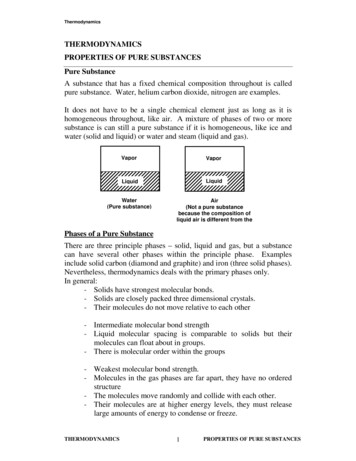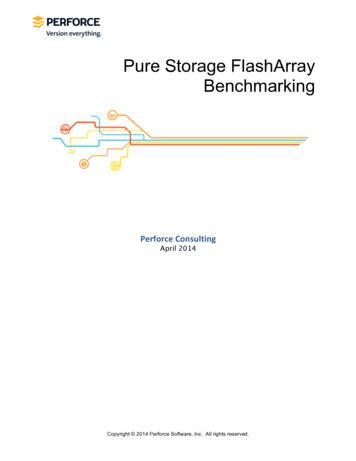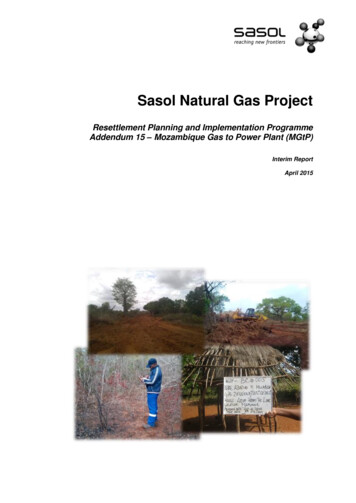
Transcription
Pure Exploration of Multi-Armed Bandits with Heavy-Tailed PayoffsXiaotian Yu, Han Shao, Michael R. Lyu, Irwin King1Department of Computer Science and EngineeringThe Chinese University of Hong Kong, Shatin, N.T., Hong Kong2Shenzhen Key Laboratory of Rich Media Big Data Analytics and Applications,Shenzhen Research Institute, The Chinese University of Hong Kong, Shenzhen, China{xtyu, hshao, lyu, king}@cse.cuhk.edu.hkAbstractInspired by heavy-tailed distributions in practical scenarios, we investigate the problemon pure exploration of Multi-Armed Bandits(MAB) with heavy-tailed payoffs by breakingthe assumption of payoffs with sub-Gaussiannoises in MAB, and assuming that stochasticpayoffs from bandits are with finite p-th moments, where p (1, ). The main contributions in this paper are three-fold. First, wetechnically analyze tail probabilities of empirical average and truncated empirical average(TEA) for estimating expected payoffs in sequential decisions with heavy-tailed noises viamartingales. Second, we propose two effectivebandit algorithms based on different prior information (i.e., fixed confidence or fixed budget) for pure exploration of MAB generatingpayoffs with finite p-th moments. Third, wederive theoretical guarantees for the proposedtwo bandit algorithms, and demonstrate the effectiveness of two algorithms in pure exploration of MAB with heavy-tailed payoffs insynthetic data and real-world financial data.1INTRODUCTIONThe prevailing decision-making model named MultiArmed Bandits (MAB) elegantly characterizes a wideclass of practical problems on sequential learning withpartial feedbacks, which was first formally proposed andinvestigated in (Robbins, 1952). In general, a predominant characteristic of MAB is a trade-off between exploration and exploitation for sequential decisions, whichhas been frequently encountered in scientific researchand various industrial applications, e.g., resource allocation, online advertising and personalized recommendations (Auer et al., 2002; Bubeck et al., 2012; Chu et al.,2011; Lattimore et al., 2015; Wu et al., 2016).Most algorithms in MAB are primarily developed tomaximize cumulative payoffs during a number of roundsfor sequential decisions. Recently, there have been interesting investigations on various variants of the traditional MAB model, such as linear bandits (Auer, 2002;Yu et al., 2017b; Zhao and King, 2016), pure exploration of MAB (Audibert and Bubeck, 2010), risk-averseMAB (Sani et al., 2012; Yu et al., 2017a), cascading bandits (Kveton et al., 2015) and clustering bandits (Kordaet al., 2016; Li et al., 2016).One non-trivial branch of MAB is pure exploration,where the goal is to find the optimal arm in a givendecision-arm set at the end of exploration. In this case,there is no explicit trade-off between exploration and exploitation for sequential decisions, which means that theexploration phase and the exploitation phase are separated. The problem of pure exploration is motivated byreal scenarios which prefer to identify an optimal arminstead of maximizing cumulative payoffs. Recent advances in pure exploration of MAB have found potentialapplications in many practical domains including communication networks and commercialized products (Audibert and Bubeck, 2010; Chen et al., 2014).In previous studies on pure exploration of MAB, a common assumption is that noises in observed payoffs aresub-Gaussian. The sub-Gaussian assumption encompasses cases of all bounded payoffs and many unboundedpayoffs in MAB, e.g., payoffs of an arm following aGaussian distribution. However, there exist non-subGaussian noises in observed payoffs for bandits, e.g.,high-probability extreme payoffs in sequential decisionswhich are called heavy-tailed payoffs. A practical motivation example for MAB with heavy-tailed payoffs isthe distribution of delays in end-to-end network routing (Liebeherr et al., 2012). Pure exploration of MABwith heavy-tailed payoffs is important, especially foridentifications of the potential optimal investment target for practical financial applications. It is worth mentioning that the case of maximizing cumulative payoffs
of MAB with heavy tails has been extensively investigated in (Bubeck et al., 2013a; Carpentier and Valko,2014; Lattimore, 2017; Medina and Yang, 2016; Vakiliet al., 2013). In (Bubeck et al., 2013a), the setting of sequential payoffs with bounded p-th moments was investigated for regret minimization in MAB, where p (1, 2].Vakili et al. (Vakili et al., 2013) introduced bounded pth moments with the support over (1, ), and provided a complete regret guarantee in MAB. In (Medina and Yang, 2016), regret guarantee in linear banditswith heavy-tailed payoffs was investigated, which is stillscaled by parameters of bounded moments. Recently,payoffs in bandits with bounded kurtosis were discussedin (Lattimore, 2017).In this paper, we investigate the problem on pure exploration of MAB with heavy-tailed payoffs characterizedby the bound of p-th moments. It is surprising to find thatless effort has been devoted to pure exploration of MABwith heavy-tailed payoffs. Compared with previous workon pure exploration of MAB, the problem of best armidentifcation with heavy-tailed payoffs has three challenges. The first challenge is the estimate of expectedpayoffs of an arm in MAB. It might not be sufficientto adopt an empirical average (EA) of observed payoffswith heavy-tailed noises for estimating a true mean. Thesecond challenge is the probability of error for the estimate of expected payoffs, which affects performance ofbandit algorithms in pure exploration of MAB. The thirdchallenge is to develop effective bandit algorithms withtheoretical guarantees for pure exploration of MAB withheavy-tailed stochastic payoffs.To solve the above three challenges, we need to introducea general assumption that stochastic payoffs in MAB arewith finite p-th moments, where p (1, ). Note thatthe case of p (1, 2] is weaker than the classic assumption of payoffs with sub-Gaussian noises in MAB. Then,under the assumption of finite p-th moments, we presenttheoretical behaviours of empirical average, and analyze the estimate of truncated empirical average (TEA).Based on different prior information, i.e., fixed confidence or fixed budget, we propose two bandit algorithmsin pure exploration of bandits with heavy-tailed payoffs. Finally, based on synthetic data with noises fromstandard Student’s t-distribution and real-world financialdata, we demonstrate the effectiveness of the proposedbandit algorithms. To the best of our knowledge, thisis the first systematic investigation on pure explorationof MAB with heavy-tailed payoffs. For reading convenience, we list contributions of this paper below. We technically analyze tail probabilities of EA andTEA to estimate true mean of arms in MAB withthe general assumption of conditionally independent payoffs. We propose two bandit algorithms for pure exploration of MAB with heavy-tailed stochastic payoffs characterized by finite p-th moments, wherep (1, ). We derive theoretical results of the proposed banditalgorithms, as well as demonstrating effectivenessof two algorithms via synthetic data and real-worldfinancial data.2PRELIMINARIESIn this section, we first present related notations and definitions in this paper. Then, we present assumptions andthe problem definition for pure exploration of MAB withheavy-tailed payoffs.2.1NOTATIONSLet A be a bandit algorithm for pure exploration ofMAB, which contains K arms at the beginning of exploration. For pure exploration, let Opt be the trueoptimal arm among K arms, where Opt [K] with[K] , {1, 2, · · · , K}. The total number of sequentialrounds for A to play bandits is T , which is also called assample complexity. The confidence parameter is denotedby δ (0, 1), which means that, with probability at least1 δ, A generates an output optimal arm Out equivalentto Opt, where Out [K]. In other words, it happenswith a small probability δ that Opt 6 Out, and δ can bealso called the probability of error.There are two settings based on different prior information given at the beginning of exploration, i.e., fixed confidence or fixed budget. For the setting of fixed confidence, A receives the information of δ at the beginning,and A generates Out when a certain condition related toδ is satisfied. For the setting of fixed budget, A receivesthe information of T at the beginning, and A generatesOut at the end of T .We present the learning process on pure exploration ofMAB as follows. For t 1, 2, · · · , T , A decides toplay an arm at [K] with historical information of{a1 , π1 (a1 ), · · · , at 1 , πt 1 (at 1 )}. Then, A observesa stochastic payoff πt (at ) R with respect to at , ofwhich the expectation conditional on Ft 1 is µ(at ) withFt 1 , {a1 , π1 (a1 ), · · · , at 1 , πt 1 (at 1 ), at } and F0being an empty set. Based on πt (at ), A updates parameters to proceed with the exploration at t 1. We storetime index t of playing arm at in Φ(at ), which is a setwith increasing integers.Given an event E and a random variable ξ, let P[E] bethe probability of E and E[ξ] be the expectation of ξ. Forx R, we denote by x the absolute value of x, and fora set S, we denote by S the cardinality of S. For anevent E, let 1[E] be the indicator function of E.
Definition 1. (Heavy-tailed payoffs in MAB) Given MABwith K arms, let π(k) be a stochastic payoff drawn fromany arm k [K]. For t 1, · · · , T , conditionalon Ft 1 , MAB has heavy-tailed payoffs with the p-thraw moment bounded by B, or the p-th central momentbounded by C, where p (1, ), B, C (0, )and k [K].2.2PROBLEM DEFINITIONIt is general to assume that payoffs during sequential decisions contain noises in many practical scenarios. Welist the assumptions in this paper for pure exploration ofMAB with heavy-tailed payoffs as follows.1. Assume that Opt , arg maxk [K] µ(k) is uniquefor pure exploration of MAB with K arms.2. Assume that MAB has heavy-tailed payoffs withthe p-th raw or central moment conditional on Ft 1bounded by B or C, for t 1, · · · , T .3. Assume that the sequence of stochastic payoffsfrom arm k [K] has noises with zero mean conditional on Ft 1 in pure exploration of MAB. Forany time instant t [T ] and the selected arm at ,we define random noise of a true payoff as ξt (at ) ,πt (at ) µ(at ), and assume E[ξt (at ) Ft 1 ] 0.Now we present a problem definition for pure exploration of MAB as follows. Given K arms satisfying Assumptions 1–3, the problem in this paper is to develop abandit algorithm A generating an arm OutT [K] after T pullings of bandits such that P[OutT 6 Opt] δ,where δ (0, 1).We discuss theoretical guarantees in two settings for bestarm identification of bandits. One is to derive the theoretical guarantee of T by fixing the value of δ, which iscalled fixed confidence. The other is to derive the theoretical guarantee of δ by fixing the value of T , which iscalled fixed budget.For simplicity of notations, we enumerate the armsaccording to their expected payoffs as a sequence ofµ(1) µ(2) · · · µ(K). In the ranked sequence,we know that Opt 1. Note that the ranking operation does not affect our theoretical guarantees. For anyarm k 6 Opt and k [K], we define the sub-optimalityas k , µ(Opt) µ(k), which leads to a sequence ofsub-optimality as { k }Kk 2 . To obtain K terms in suboptimality, which helps theoretical analyses, we furtherdefine 1 , 2 . Inspired by (Audibert and Bubeck,2010), we define the hardness for pure exploration ofMAB with heavy-tailed payoffs by quantities asH2p , max k p 1 pk .k [K](1)3RELATED WORKPure exploration in MAB, aiming at finding the optimal arm after exploration among a given decision-armset, has become an attracting branch in the decisionmaking domain (Audibert and Bubeck, 2010; Bubecket al., 2009; Chen et al., 2014; Gabillon et al., 2012,2016; Jamieson and Nowak, 2014). It has been pointedout that pure exploration in MAB has many applications,such as communication networks and online advertising.For pure exploration of MAB with payoffs under subGaussian noises, theoretical guarantees have been wellstudied. Specifically, in the setting of fixed confidence,the first distribution-dependent lower bound of samplecomplexity was Pdeveloped in (Mannor and Tsitsiklis,2004), which is k [K] 2k . Even-Dar et al. (2002)originally proposed a bandit algorithm via successiveelimination for bounded payoffs with an upper boundof sample complexity matching the lower bound up toa multiplicative logarithmic factor. Karnin et al. (2013)proposed an improved bandit algorithm, which achievesan upper bound of sample complexity matching thelower bound up to a multiplicative doubly-logarithmicfactor. Jamieson et al. (2014) proved that it is necessaryto have a multiplicative doubly-logarithmic factor in thedistribution-dependent lower bound of sample complexity. Jamieson et al. also developed a bandit algorithmvia the law of iterated logarithm algorithm for pure exploration of MAB, which achieved the optimal samplecomplexity of the problem.In the setting of fixed budget with payoffs under subGaussian noises, (Audibert and Bubeck, 2010) developed a distribution-dependent lower bound of probability of error, and provided two algorithms, which achieveoptimal probability of error up to logarithmic factors.Gabillon et al. (2012) proposed a unified algorithm forfixed budget and fixed confidence, which discusses optimal learning in best arm identification of MAB.Karnin et al. (2013) proposed a bandit algorithm via sequential halving to improve probability of error by a multiplicative constant. It is worth mentioning that (Kaufmann et al., 2016) investigated best arm identification ofMAB under Gaussian or Bernoulli assumption, and provided lower bounds in terms of Kullback-Leibler divergence. We also notice that there are extensions of bestarm identification of MAB, which is multiple-arm identification (Bubeck et al., 2013b; Chen et al., 2014).To the best of our knowledge, there is no investigationon pure exploration of MAB without the strict assumption of payoffs under sub-Gaussian noises. There aresome potential reasons for this fact. One main reasoncan be that, without sub-Gaussian noises, the tail probabilities of estimates for expected payoffs can be heavy
Table 1: Comparisons on distributional assumptions and theoretical guarantees in pure exploration of MAB. Note weomit constant factors in the following inequalities, and H1 , H2 and H3 can refer to the corresponding work.settingworkEven-Dar et al. (2002)assumption on payoffsbounded payoffs in [0, 1]algorithmSEMEfixed δKarnin et al. (2013)bounded payoffs in [0, 1]EGEJamieson et al. (2014)sub-Gaussian noiseLILUCBKaufmann et al. (2016)two-armed Gaussian banditsα-Etheoretical guarantee i 2KP T 1 δk 1 k logδ kh iK1P T 2 log δ 1 δh iPK 211P T 1 δk 1 k logδ log k P T H1 log δ1 H3 1 4 cδ 4cδ (σ σ )2P T (µ1 µ2 )2 log δ1 1 δhPK1"our workfinite p-th momentsP T SE-δ(EA) PKk 1 with p (1, 2]Audibert and Bubeck (2010)bounded payoffs in [0, 1]SE-δ(TEA)UCB-ESRfixed TGabillon et al. (2012)bounded payoffs in [0, b]UGapEbKarnin et al. (2013)bounded payoffs in [0, 1]SHKaufmann et al. (2016)two-armed Gaussian banditsSSour workfinite p-th momentsSE-T (EA)with p (1, 2]SE-T (TEA)P T 222p 1 KCp δk120B p kPKk 1! 1p 1pp 14ALGORITHMS AND ANALYSESIn this section, we first investigate two estimates, i.e., EAand TEA, for expected payoffs of bandits, and derive tailprobabilities for EA and TEA under sequential payoffs.Then, we develop two bandit algorithms for best armidentification of MAB in the spirit of successive elimination (SE) and successive rejects (SR). In particular,SE is for the setting of fixed confidence and SR is forthe setting of fixed budget. Finally, we derive theoreti- 1 δ2Kδlog 1 δ KP[Out 6 Opt] T K exp TH1 T KP[Out 6 Opt] K(K 1) exp log(K)H2 KP[µOut µOpt ] T K exp TH TP [Out 6 Opt] log(K) exp log(K)H2 (µ1 µ2 )2 TP [Out 6 Opt] exp 2(σ2 σ )1P[Out 6 Opt] 2p 1CK(K P[Out 6 Opt] 2K(K 1) exp21)H2p because Chernoff-Hoeffding inequalities of estimates donot hold in general. The failure of Chernoff-Hoeffdinginequalities of estimates is a big challenge in pure exploration of MAB. In this paper, we investigate theoreticalperformance of pure exploration of MAB with heavytailed stochastic payoffs characterized by finite p-th moments, where p (1, ). We will put more effortson p (1, 2] because the case of p (2, ) enjoysa similar format of p 2. To compare our work withprior studies, we list the distributional assumptions andtheoretical guarantees in pure exploration of MAB in Table 1. Finally, it is worth mentioning that the case ofmaximizing expected cumulative payoffs of MAB withheavy tails has been extensively investigated in (Bubecket al., 2013a; Carpentier and Valko, 2014; Medina andYang, 2016; Vakili et al., 2013).# K̄T K p 1(T K)B̄1K̄K p/(1 p) cal guarantees for each bandit algorithm, where we takeadvantage of EA or TEA.4.1 EMPIRICAL ESTIMATESIn SE and SR, it is common for A to maintain a subset ofarms St [K] at time t 1, 2, · · · and A will output anarm when a certain condition is satisfied, e.g., St 1in the setting of fixed confidence. Similar to the most frequently used estimates for expected payoffs in MAB, weconsider the following EA to estimate expected payoffsfor any arm k St :1 Xµ̂t (k) ,πi (k),(2)st,ki Φ(k)where st,k , Φ(k) at time t. Note that the number ofelements in Φ(k) will increase or hold with time evolution, and the elements in Φ(k) may not successively increase. We also investigate the following estimator TEAfor any arm k St :1 Xµ̂†t (k) ,πi (k)1[ πi (k) bi ] ,(3)st,ki Φ(k)where bi 0 is a truncating parameter, and bi will becompletely discussed in the ensuing theoretical analyses.We do not discuss the estimator called median of means(MoM) shown in (Bubeck et al., 2013a), because theo-
retical guarantees of MoM enjoy similar formats to thoseof TEA. Before we prove concentration inequalities forestimates via martingales, we have results as below.Proposition 1. (Dharmadhikari et al., 1968; von Bahret al., 1965) Let {νi }ti 1 be random variables satisfying E[ νi p ] Cand E[νi Fi 1 ] 0. If p (1, 2],hPpit 2tC. If p (2, ),then we have Ei 1 νihPpit Cp Ctp/2 , where Cp ,then we have Ei 1 νi p8(p 1) max(1, 2p 3 ) .Proposition 2. (Seldin et al., 2012) Let {νi }ti 1 berandom variables satisfying νi bi with {bi }ti 1 being a non-decreasing sequence, E[νi Fi 1 ] 0 andE[νi2 Fi 1 ] is bounded. Then, with probability 1 δ,Ptwe havei 1 νi bt log(2/δ) Vt /bt , and Vt Pt2i 1 E[νi Fi 1 ].Lemma 1. In pure exploration of MAB with K arms, forany t [T ] and any arm k St , with probability 1 δ for EA, we have µ̂t (k) µ(k) µ̂t (k) µ(k) 1p2C, 1 p 2,p 1st,k δCp C 1pP[ µ̂t (k) µ(k) δ] Cp Cp/2st,k δ p,(6)where we adopt Proposition 1. With probability 1 δCp C µ̂t (k) µ(k) ! p1.p/2(7)st,k δNow we prove the results with the estimator µ̂†t (k),where k St . Considering bi in Eq. (3), we define µ†i (k) , E πi (k)1[ πi (k) bi ] Fi 1 , and ζi (k) ,µ†i (k) πi (k)1[ πi (k) bi ] , for any i Φ(k). Wehave ζi (k) 2bi , E[ζi (k) Fi 1 ] 0 andE πi (k)1[ πi (k) bi ] Fi 1 B/bp 1. Besides, weialso haveµ(k) µ̂†t (k)i1 X h µ(k) µ†i (k)st,ki Φ(k)i1 X h †µi (k) πi (k)1[ πi (k) bi ] st,ki Φ(k), p 2;p/2st,k δ for TEA, we have p 1 µ̂† (k) µ(k) 5B p1 log(2/δ) p , 1 p 2,tst,k 1 µ̂† (k) µ(k) 5B p1 log(2/δ) 2 , p 2.tFor p (2, ), we havest,k1Xst,k E πi (k)1[ πi (k) bi ] Fi 1 ζi (k) ,i Φ(k)†which implies of µ(k) µ̂t (k) the inequalityP1Bi Φ(k) bp 1 ζi (k) . For p (1, 2], we havest,ki B.E[ζi2 (k) Fi 1 ] E πi2 (k)1[ πi (k) bi ] Fi 1 bp 2iProof. We first prove the results with the estimator µ̂t (k)with k St . By Chebyshev’s inequality, we haveE[ µ̂t (k) µ(k) p ]P[ µ̂t (k) µ(k) δ] δpPE[ i Φ(k) πi (k) µ(k) p ] ,spt,k δ pX(4)pBased on Assumption 2, we have E[ ξi (k) ] C andE[ξi (k) Fi 1 ] 0 for any i Φ(k) at t. For p (1, 2],hPpiEi Φ(k) ξi2CP[ µ̂t (k) µ(k) δ] p 1 ,ppst,k δst,k δ pwhere we adopt Proposition 1. Thus, for any arm k St ,with probability at least 1 δ µ̂t (k) µ(k) sp 1t,k δζi (k) 2bt log(2/δ) i Φ(k)where δ (0, 1) and st,k is fixed at time t.2CBased on Proposition 2, with probability at least 1 δ! p1(5)i Φ(k)B 2bt log(2/δ) st,k p 1 ,2bt(8)where we adopt the design of {bi }i Φ(k) as a nondecreasing sequence, i.e., b1 b2 · · · bt . Thus, p1 Bst,k, with probability at leastby setting bt log(2/δ)1 δ, we have µ̂†t (k) µ(k) 5B1p log(2/δ)st,k p 1p,(9)where we adopt the fact of1.1 XE[ζi2 (k) Fi 1 ]2btst,kXBi Φ(k)bp 1i 2B1p log(2/δ)st,k p 1p.(10)
For p (2, ), by Jensen’s inequality, we have2E[ζi2 (k) Fi 1 ] B p .Algorithm 1 Successive Elimination-δ (SE-δ(TEA))(11)By converting the condition in p (2, ) to the condition in p 2 with Jensen’s inequality and using Eq. (9),with probability at least 1 δ, we have1 µ̂†t (k) µ(k) 5B p log(2/δ)st,k 12,(12)which completes the proof.Remark 1. In (Bubeck et al., 2013a; Vakili et al., 2013),the Bernstein inequality without martingales is adoptedwith an implicit assumption of sampling payoffs of anarm being independent of sequential decisions, which isinformal. By contrast, in Lemma 1, conditional on Ft 1 ,the subset St is fixed, and we adopt Bernstein inequality with martingales. Thus, we break the assumptionof independent payoffs in previous work, and prove formal theoretical results of tail probabilities of estimatorsEA and TEA. Note that the superiority of martingales insequential decisions has been fully discussed in (Zhaoet al., 2016).Remark 2. The concentration results with martingalesin Lemma 1 for p (1, ) can also be applied into regret minimization of heavy-tailed payoffs and other applications in sequential decisions. In particular, we observe that the concentration inequality of p 2 recovers that of payoffs under sub-Gaussian noises. Besides,when p 2, the concentration results indicate constantvariations with respect to B. Note that, in Lemma 1,we analyze concentration results when p 2, which hasnot been analyzed in (Bubeck et al., 2013a). Comparedto (Vakili et al., 2013), the concentration result in ourwork for TEA when p 2 enjoys a constant improvement. Since the case of p (2, ) can be resolved byp 2, we will focus on p (1, 2] in bandit algorithmsfor pure exploration of MAB with heavy-tailed payoffs.4.2 FIXED CONFIDENCEIn this subsection, we present a bandit algorithm for pureexploration of MAB with heavy-tailed payoffs under afixed confidence. Then, we derive upper bounds of sample complexity of the bandit algorithms.4.2.1 Description of SE-δIn fixed confidence, we design our bandit algorithmfor pure exploration of MAB with heavy-tailed payoffsbased on the idea of SE, which is inspired by (Even-Daret al., 2002). For SE-δ(EA), the algorithmic proceduresare almost the same as that in (Even-Dar et al., 2002),which are omitted here. For SE-δ(TEA), A will output anarm Out when St 1 with computation details shown1: input: δ, K, p, B2: initialization: µ̂†1 (k) 0 for any arm k [K], S1 [K], and b1 03: t 1. begin to explore arms in [K]4: while St 1 do p 11p5:ct 5B p log(2K/δ). update confidence boundt 1pBt6:bt log(2K/δ). update truncating parameter7:for k St do8:play arm k and observe a payoff πt (k)P. calculate TEA9:µ̂†t (k) 1t ti πi (k)1[ πi (k) bi ]10:end for†11:at arg maxk [K] µ̂t (k). choose the best arm at t12:St 1 . create a new arm set for t 113:for k St do14:if µ̂†t (at ) µ̂†t (k) 2ct then15:St 1 St 1 {k}. add arm k to St 116:end if17:end for18:t t 1. update time index19: end while20: Out St [0]. assign the first entry of St to Out21: return: Outin Algorithm 1, where δ is a given parameter. The ideais to eliminate the arm which has the farthest deviationcompared with the empirical best arm in St .4.2.2 Theoretical Guarantee of SE-δWe derive upper bounds of sample complexity of SE-δwith estimators of EA and TEA. Note that T is the timecomplexity of SE-δ.Theorem 1. For pure exploration in MAB with K arms,with probability at least 1 δ, Algorithm SE-δ identifiesthe optimal arm Opt with sample complexity as for SE-δ(EA)1T K 2p 1X2KC p 1 pk δk 1; for SE-δ(TEA)T KXk 1120B p kp! p 1 log2Kδ ,where p (1, 2].Proof. We first consider EA in Eq. (2) for estimating theexpected payoffs in MAB. For p (1, 2], for any armk St , we haveP[ µ̂t (k) µ(k) δ] 2Ctp 1 δ p,(13)
where we adopt st,k t in SE-δ(EA). We notice theinherent characteristic of SE that, for any arm k St ,we have Φ(k) {1, 2, · · · , t}.Algorithm 2 Successive Rejects-T (SR-T (TEA))(15)1: input T , K, p, B, 02: initialization: µ̂† (k) 0 for any arm k [K], S1 P1[K], n0 0, b 0 and K̄ Ki 1 i 1 p 13: b 3Bp. calculate truncating parameter 4: for k S1 do5:Φ(k) . construct sets to store time index6: end for7: for k [K 1] doT Ke. calculate nk at stage k8:nk d K̄(K 1 k)9:n nk nk 1. calculate the number of times to pull arms10:for y Sk do11:for i [n] do12:t t 113:play arm y, and observe a payoff πt (y)14:Φ(y) Φ(y) {t}. store time index for arm y15:end forP116:µ̂†k (y) Φ(y) i Φ(y) πi (y)1[ πi (y) b]17:end for18:ak arg miny Sk µ̂†t (y). choose the worst arm at k19:Sk 1 Sk {ak }. successively reject arm ak20: end for21: Out SK [0]. assign the first entry of SK to Out22: return: OutTo solve the above inequality, we are ready to have that1 p 1 2p 1is sufficient. The total sampletk 2 p KCkδPKcomplexity is T t2 k 2 tk , because the numberof pulling the optimal arm t1 t2 . This implies, withprobability at least 1 δ, we haveidea is to conduct non-uniform pulling of arms by K 1phases, and SR-T rejects a worst empirical arm for eachphase. The reject operation is based on EA or TEA,and we distinguish the two cases by SR-T (EA) and SRT (TEA).Based on Lemma 1, for t 1, 2, · · · , with probability atleast 1 δ/K, the following event holdsEt , {k St , µ̂t (k) µ(k) ctk } , p1is a confidence interval.where ctk 2KC/(tp 1δ)kTo eliminate a sub-optimal arm k, we need to play anyarm k [K]\Opt with tk times such thatˆ k , µ̂t (Opt) µ̂t (k) 2ct . kkk(14)Based on Lemma 1, with a high probability, we haveˆ k µ(Opt) ct (µ(k) ct ) k 2ct , kkkwhere ctk is a confidence interval. To satisfy Eq. (14),we are ready to set k 2ctk 2ctk .1T K 2p 1X2KC p 1 pk δk 1.(16)Now we consider TEA in Eq. (3) for estimating the expected payoffs in MAB. Similarly, for p (1, 2], withprobability at least 1 δ, we haveT KXk 1120B p kp! p 1 log2Kδ ,(17)which completes the proof.4.3 FIXED BUDGETIn this subsection, we present a bandit algorithm for pureexploration of MAB with heavy-tailed payoffs under afixed budget. Then, we derive upper bounds of probability of error for the bandit algorithms.4.3.1 Description of SR-TFor SR-T (EA), we omit the algorithm because it is almost the same as that in (Audibert and Bubeck, 2010).For SR-T (TEA), we design a bandit algorithm for pureexploration of MAB with heavy-tailed payoffs based onthe idea of SR, with computation details shown in Algorithm 2, where T is a given parameter. The high-levelFor simplicity, we show SR-T (TEA) in Algorithm 2,where 0 is a design parameter for the estimatorof TEA. The design parameter helps to calculate thetruncating parameter b in SR-T (TEA). Usually, we set k for any k [K].4.3.2 Theoretical Guarantee of SR-TWe derive upper bounds of probability of error for SR-Twith estimators of EA and TEA. We have the followingtheorem for SR-T .Theorem 2. For pure exploration in MAB with K arms,if Algorithm SR-T is run with a fixed budget T , we haveprobability of error for p (1, 2] as for SR-T (EA)P[Out 6 Opt] 2p 1 CK(K 1)H2p K̄T K p 1; for SR-T (TEA) (T K)B̄1P[Out 6 Opt] 2K(K 1) exp ,K̄K p/(1 p)where B̄1 p 114(2p 3Bpp ) p 1.
Proof. We first consider EA in Eq. (2) for estimating theexpected payoffs in MAB. For p (1, 2], we haveP[Out 6 Opt] K 1XKXTable 2: Statistics of used synthetic data.dataset#arms{µ(k)}heavy-tailed{p, B, C}S110one arm is 2.0 andnine arms are over[0.7, 1.5] with auniform gap{2, 7, 3}S210one arm is 2.0 andnine arms are over[1.0, 1.8] with auniform gap{2, 7, 3}P [µ̂k (Opt) µ̂k (i)]k 1 i K 1 k K 1XKXP [µ̂k (i) µ(i) µ(Opt) µ̂k (Opt) i ]k 1 i K 1 k K 1XKX4C K 1X i2np 1ik 1 i K 1 k2p 2 Ckp 1 p K 1 kk 1 nk(18) p,(19)where the inequality of Eq. (18) is due to the results inLemma 1 by setting st,k nk . Besides, we notice thatnp 1 pK 1 kk1 pH2 T KK̄ p 1,(a) S1Figure 1: Sample complexity for SE-δ in pure exploration of MAB with heavy-tailed payoffs.which implies thatP[Out 6 Opt] 2(b) S2p 1CK(K 1)H2p K̄T K p 1.Now we consider TEA in Eq. (3) for estimating the expected payoffs in MAB. By considering the design of bin SR-T (TEA), we have a similar result of Lemma 1.Then, for p (1, 2], we have probability of error as(a) S1P[Out 6 Opt] K 1XKXhi††P µ̂k (Opt) µ̂k (i)Figure 2: Probability of error for SR-T in pure exploration of MAB with heavy-tailed payoffs.k 1 i K 1 k K 1XKXhi††P µ̂k (i) µ(i) µ(Opt) µ̂k (Opt) k 1 i K 1 k 2K(K 1) exp (T K)B̄1K̄K p/(1 p) ,(20)which completes the proof.5(b) S2EXPERIMENTSIn this section, we conduct experiments via syntheticand real-world data to evaluate the performance of theproposed bandit algorithms. We run experiments in apersonal computer with Intel CPU@3.70GHz and 16GBmemory. For the setting of fixed confidence, we comparethe sample complexities of SE-δ(EA) and SE-δ(TEA).For the setting of fixed budget, we compare the errorprobabilities of SR-T (EA) and SR-T (TEA).5.1 SYNTHETIC DATA AND RESULTSFor ver
of two algorithms via synthetic data and real-world financial data. 2 PRELIMINARIES In this section, we first present related notations and def-initions in this paper. Then, we present assumptions and the problem definition for pure exploration of MAB with heavy-tailed payoffs. 2.1 NOTATIONS Let Abe a bandit algorithm for pure exploration of









